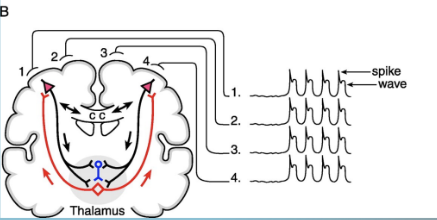Lecture 3: Epilepsy and Neuroplasticity
1/58
Earn XP
Description and Tags
Name | Mastery | Learn | Test | Matching | Spaced |
|---|
No study sessions yet.
59 Terms
What is epilepsy classified as?
brain disease
Definition of epilepsy
chronic medical condition produced by temporary changes in the electrical function of the brain, causing seizures which affect awareness, movement, and/or sensation
% of the population affected by epilepsy
0.5-1%
Who is most affected by epilepsy
children and the elderly
Duration of epilepsy
chronic- can be life long, or a few years
What type of population distribution does epilepsy have?
bimodal for age
Simply, what happens to brain waves causing seizures?
big synchronisation of waves of activity → seizures
Cause of epilepsy
idiopathic
no single cause
often no known clear cause as to why sm1 is experiencing epilepsy and why they are at a specific time
Factors that may cause epilepsy
brain injury, swelling in brain, hydrocephalous
What determines epilepsy symptoms?
type of epilepsy and location of epileptic activity
Is a diagnosis of ‘epilepsy’ that useful?
no
not very informative or useful
b/c heterogeneity of disease types
affect individual differently
require treatment/adjustment in different ways
Two main subtypes of epilepsy
partial
generalised
(big distinction between two)
Partial epilepsy
not involving whole brain
Generalised epilepsy
involving much wider range of functions
What does knowing the type of epilepsy enable?
knowing type of seizure, when might happen, why might happen, what is required
Partial epilepsy: seizures
simple partial seizures
complex partial seizures
Generalised epilepsy: seizures
grand mal seizures
petit mal seizures
Simple partial seizures: neural level
localised to specific areas of brain
problematic electrical activity, overly synchronised waves of neurons → only in one part of brain
Simple partial seizures: effects
localised effects according to localisation of epileptiform activity
usually sensory and/or motor
Jacksonian March
simple partial seizures
wave of sensation travelling down arm
localised jerking beginning in hand and progressing to clonic movements of entire arm (focal motor seizure))
produced by epileptiform activity in the motor cortex that controls the arm
→ can infer movement in seizure activity and spread re sensory and motor changes in arm
What does this describe:
“localised jerking beginning in right hand and progressing to clonic movements of entire right arm”
partial epilepsy > simple partial seizure > Jacksonian March
Complex partial seizures are also referred to as…
focal onset impaired awareness seizures
temporal lobe epilepsy
Complex partial seizures: neural level
partial
localised to specific brain areas
common localisation in temporal lobe (about 50% adult epileptics are complex partial, temporal lobe)
Complex partial seizures: effects
associated with apparently ordered/ co-ordinated, but inappropriate, motor behaviour
e.g.: running, chewing, buttoning
may be absent (impaired consciousness)
partial consciousness, moving about, awareness impaired
could know someone is speaking but be unable to respond
lasts a few mins
often no memory of episode
quick recovery time
focus on impaired awareness, but some motor symptoms
no running awareness through period of seizure even though may appear quite normal
Earliest start point of partial seizure
aura
What do auras precede?
partial seizures
Aura: definition
abnormal sensations, e.g.:
sense of fear, doom
rising feeling in abdomen
strange tastes or odours - ‘metallic’
sensory disturbances
visual sensations akin to hallucinations
Cause of aura
abnormal electrical activity originating from seizure focus
epileptic activity starts to increase before huge waves → low level changes
What are petit mal seizures also referred to as?
absence seizures
Petit mal seizures: neural level
can involve entire brain
large area of brain disrupted by seizure activity
generalised
whole brain, but at quite low level
What can petit mal seizures appear like?
conscious seizures
Petit mal seizures: effects
person briefly ‘absent’
disrupted consciousness
very brief, sometimes just 1 sec
may look like zooming out
can have some eye or lip movement resembling normal movement
able to maintain stream of dialogue sometimes
unaware
gaps - like a pause button
Petit mal seizures + school children
can be seen as daydreaming, not paying attention
miss things in class and be unaware
unaware during brief absence seizure episodes
difficult to pick up on
important to diagnose and pick up early on
Why is absence different to partial seizure?
can’t do any level of interaction
Which two seizure types have high overlap?
petit mal and complex partial
Petit mal most common in…
children
tends to subside or reduce after puberty
Grand mal seizures: neural level
can involve whole brain
usually does to some level
generalised
Grand mal seizures aka as…
tonic clonic seizures
Tonic phase
rigidly extend limbs
Clonic phase
jerks in all extremities
Grand mal seizures: effects
may lose consciousness and/or fall to ground
rigidly extend all limbs (tonic phase)
then have jerks in all extremities (clonic phase)
tend to make more of impact bc of nature of it
Commonality of grand mal seizures
less common than other types
lot of epilepsy not this
Are types of epilepsy mutually exclusive?
no
Further spreading of epileptic activity
partial seizures can generalise
can begin w/ partial seizures that then becomes generalised epilepsy

What does this show?
partial seizure generalising
in focal: normal in 1 and 2, abnormal in 3 and 4
after a while, may spread, so abnormal in 1,2,3,4
referred to as focal with secondary generalisation
can also spread to thalamus, and via the thalamus
Thalamus
big group of nuceli at base of brain, relay station

What does this show?
generalised seizure
primary generalised seizure
abnormal in 1,2,3,4
How do seizures generalise?
capacity for seizure activity to spread and spread through major connecting pathways in brain
can spread to/via the thalamus
big white matter pathways linking millions of neurons
seizure activity in group of neurons > neurons connected to other groups of neurons through axons/white matter pathways > seizure activity can transfer across
transfer pathways = (usually) big white matter pathways
connection between left and right hemisphere- corpus callosum- enables spread
Transfer pathways
usually big white matter/ myelinated axon pathways linking millions of neurons
What is white matter made up of?
myelinated axon pathways